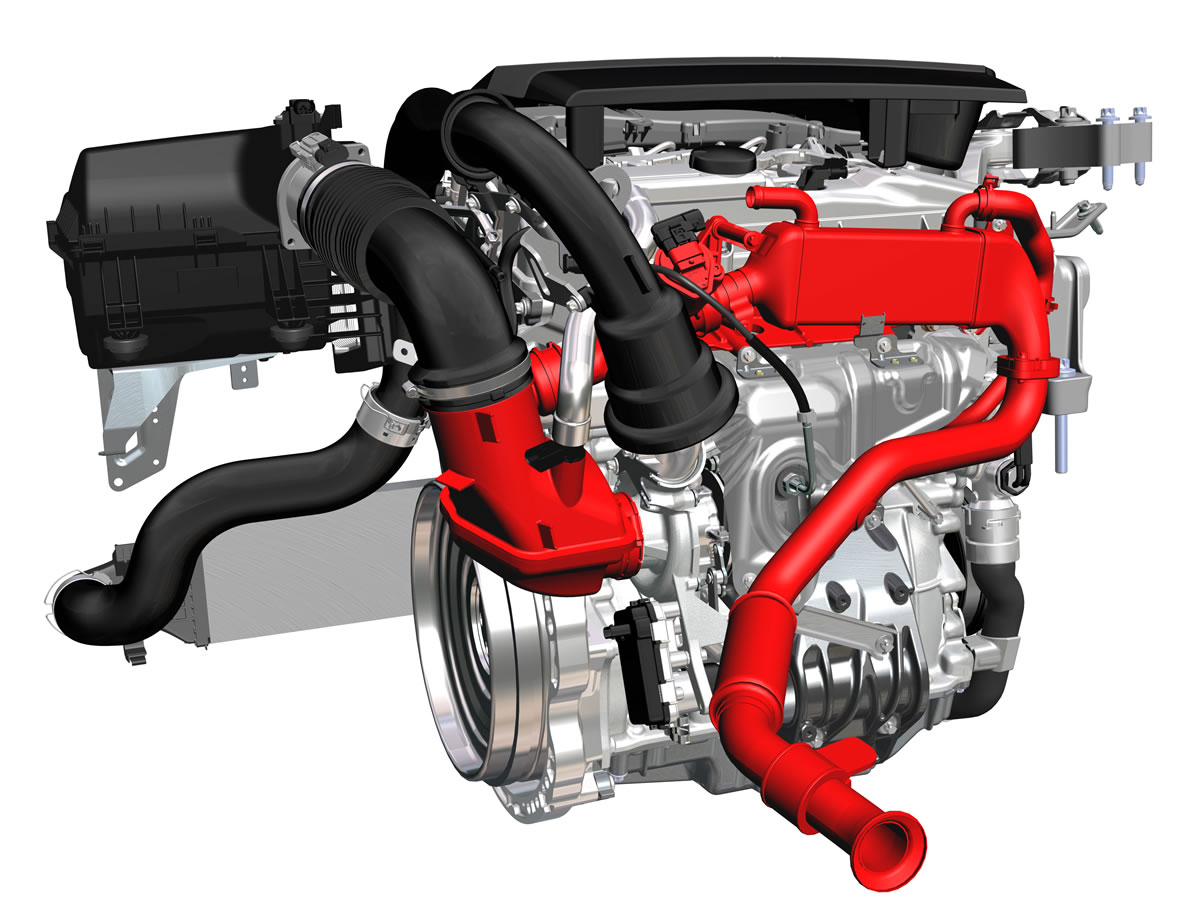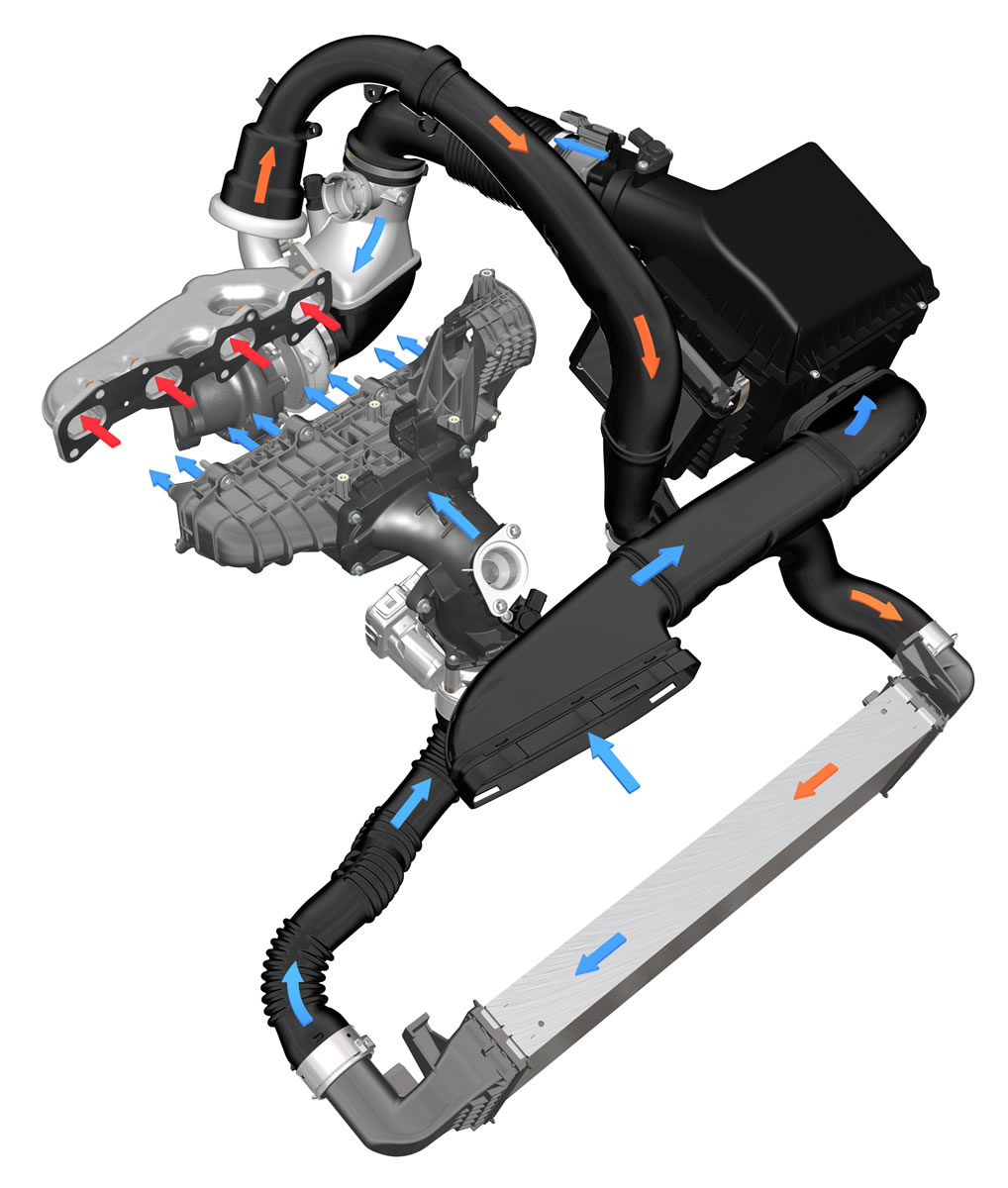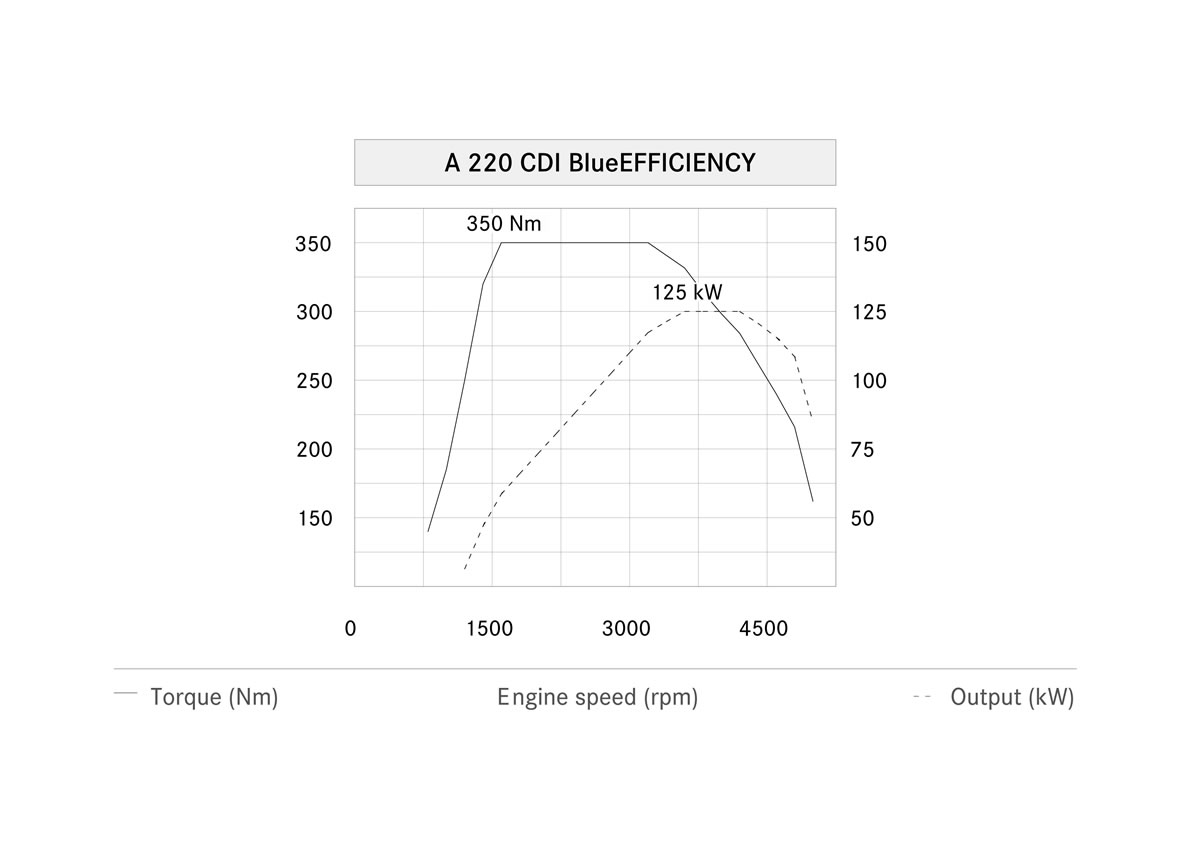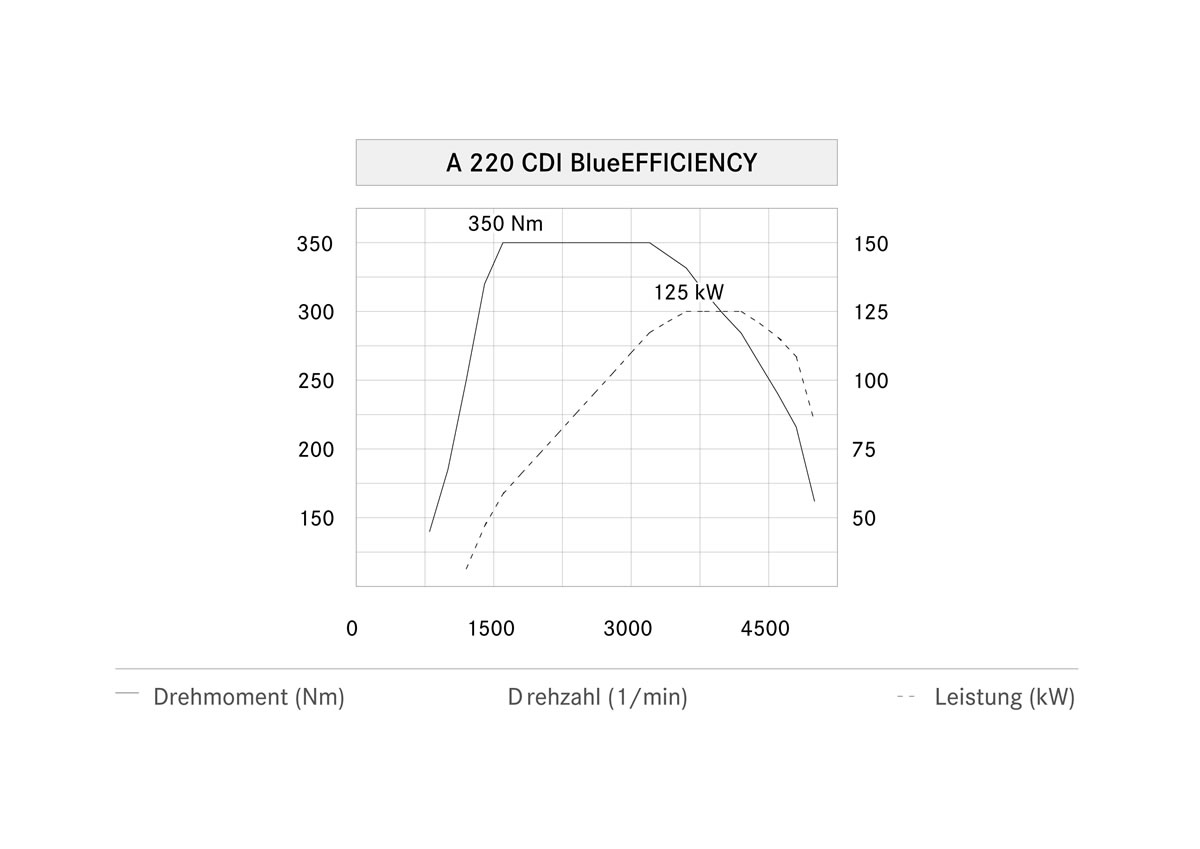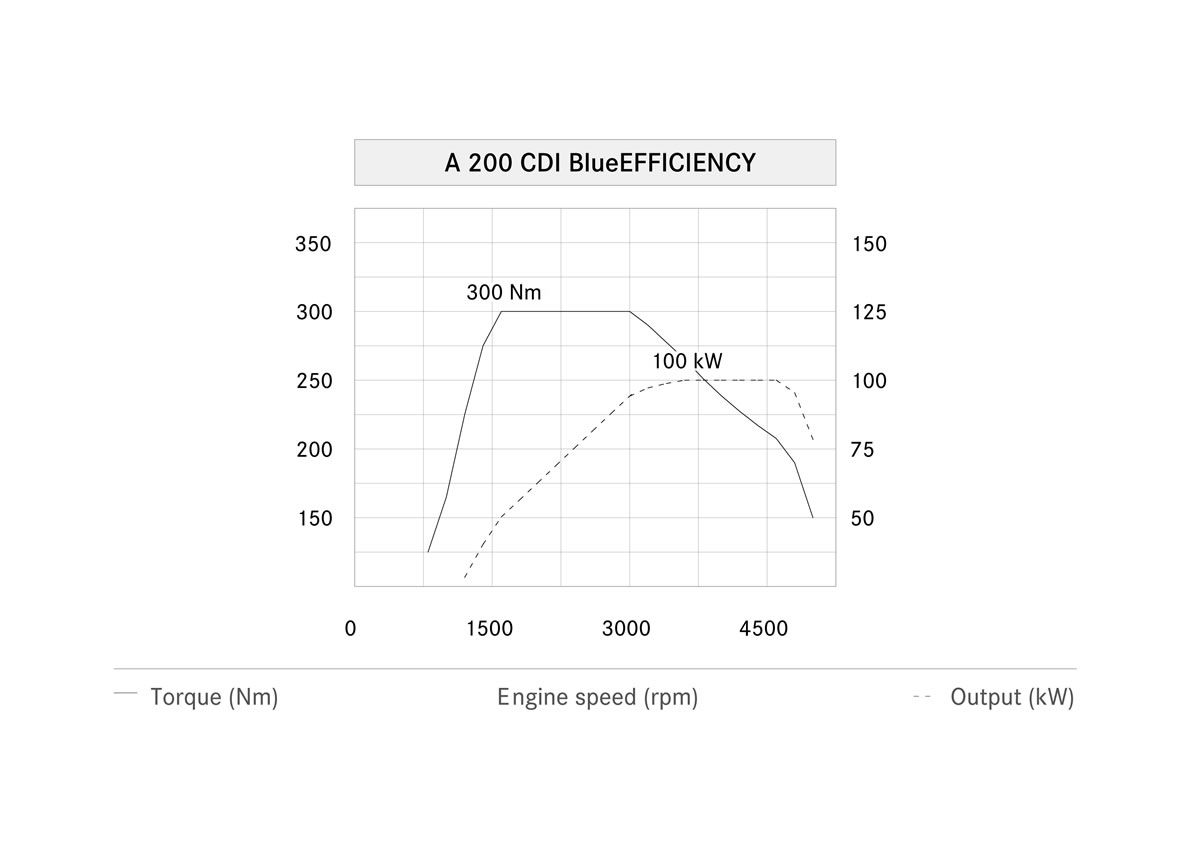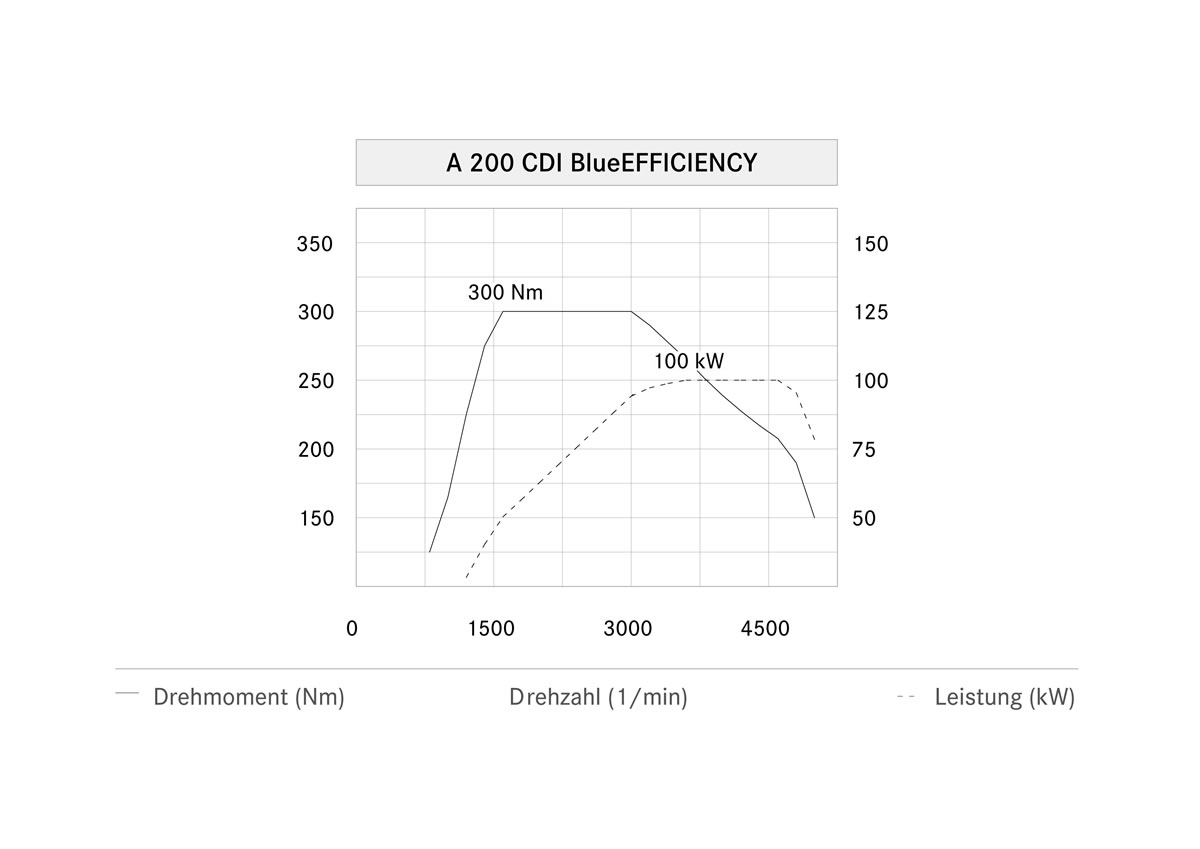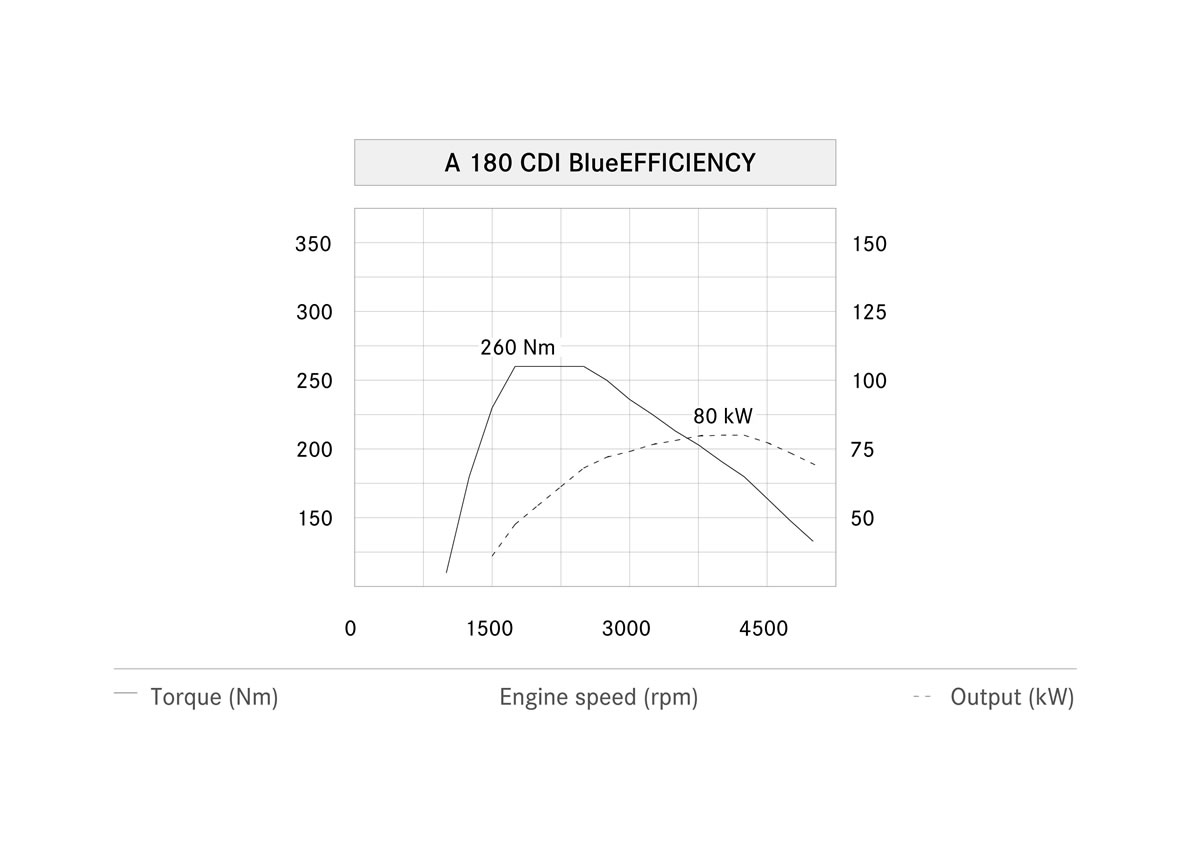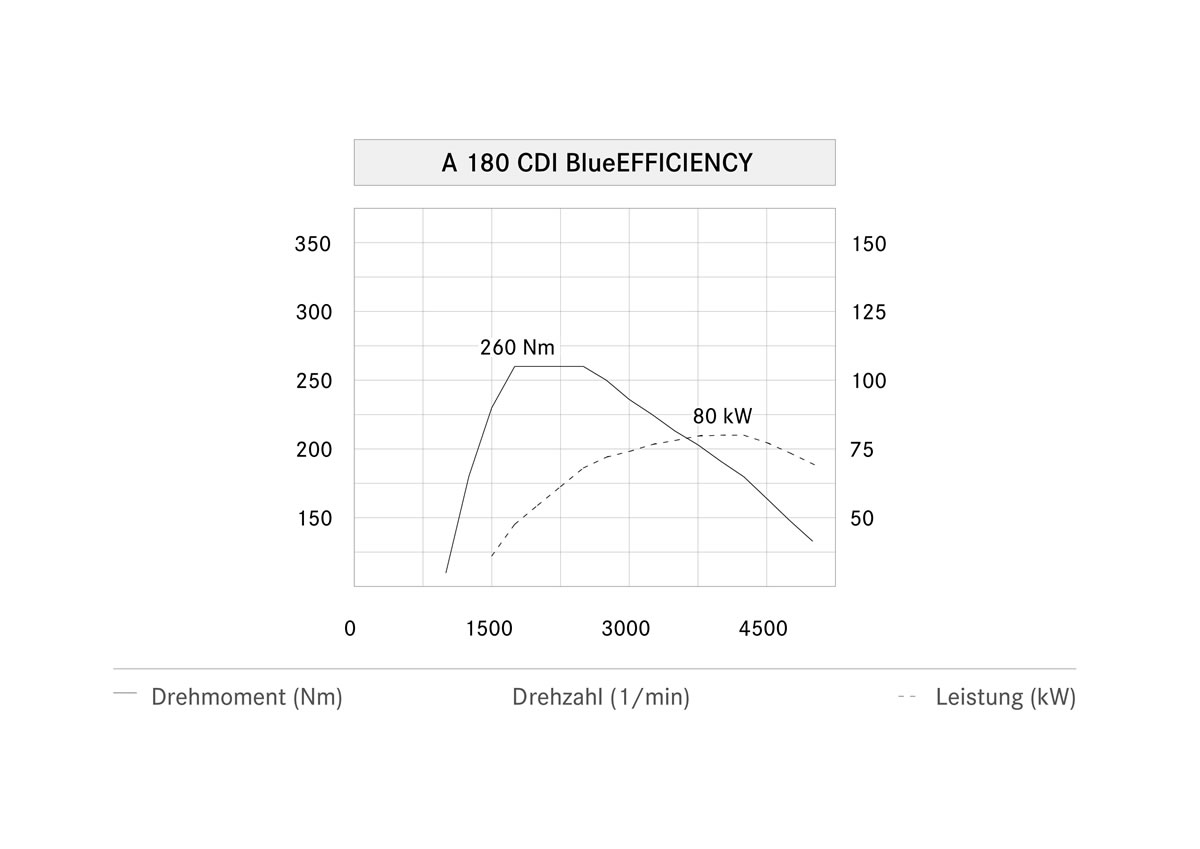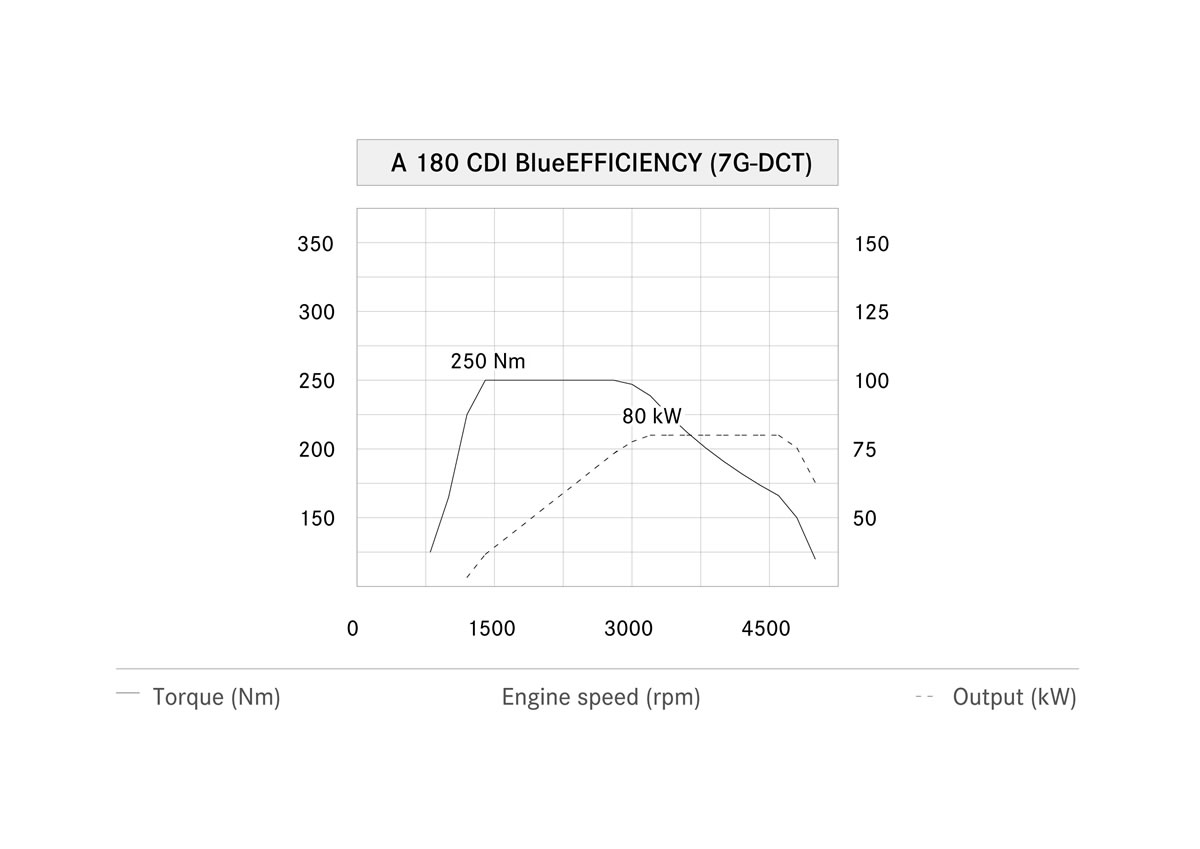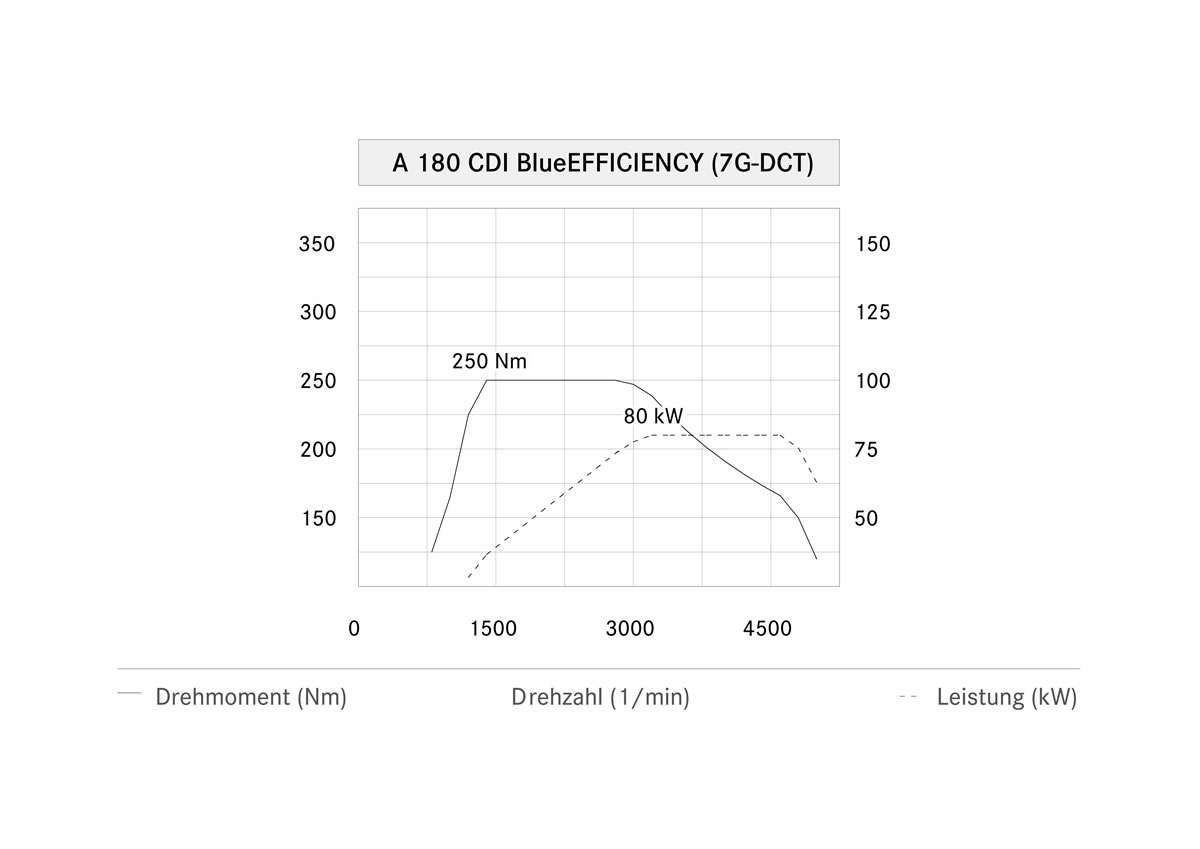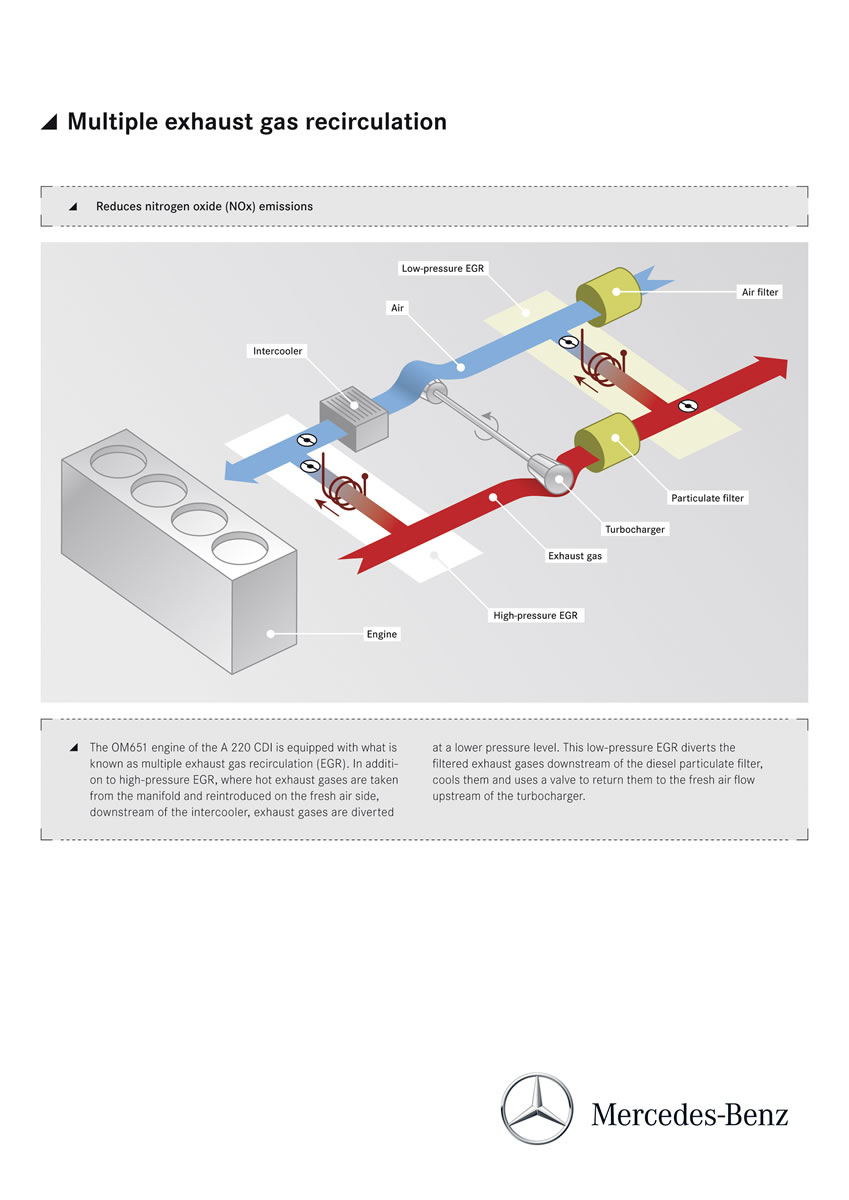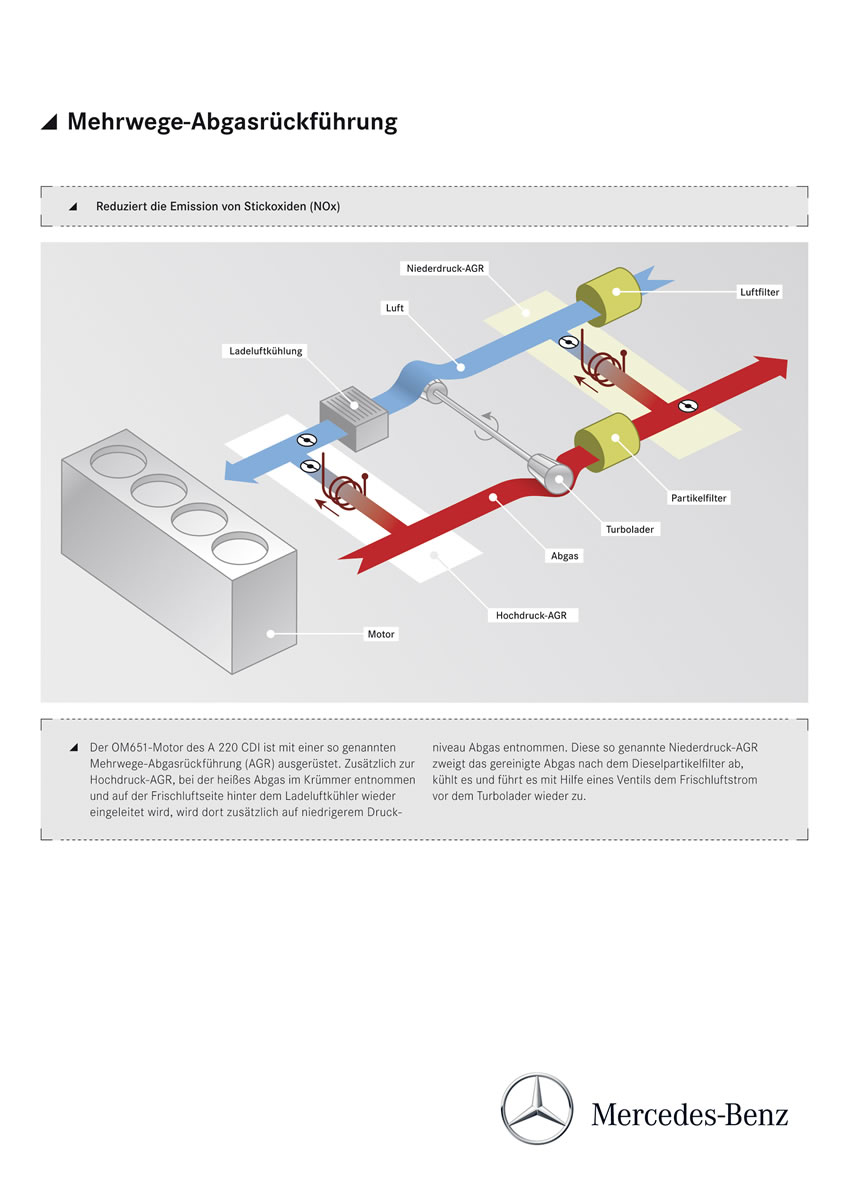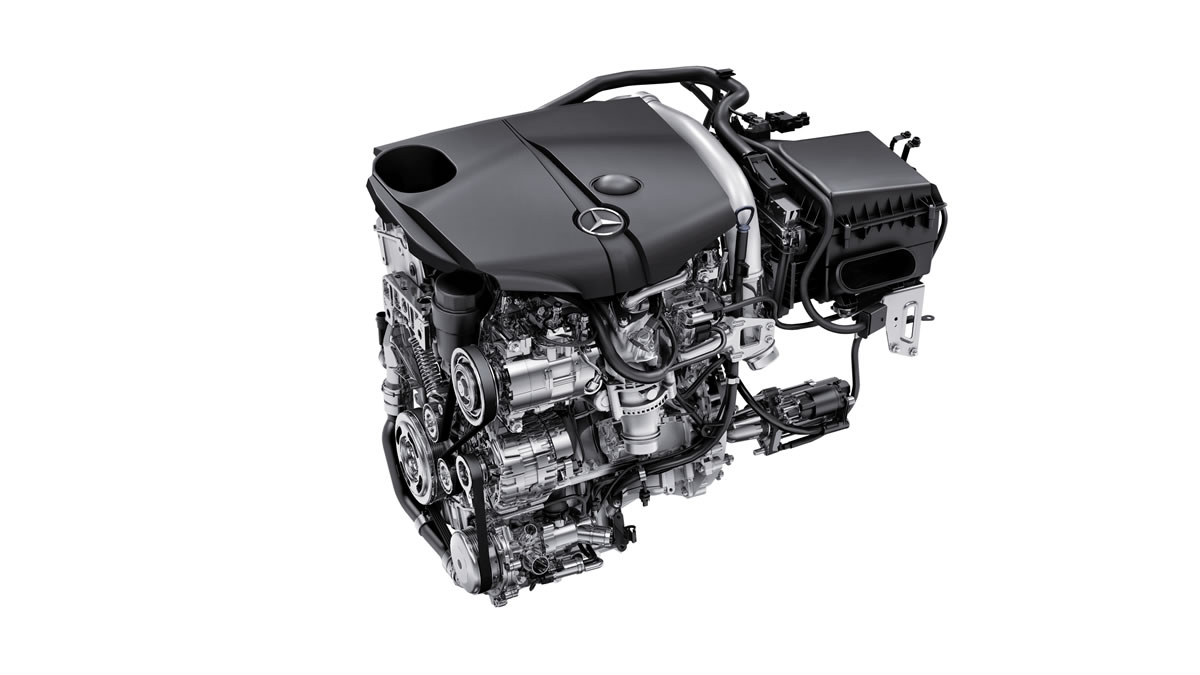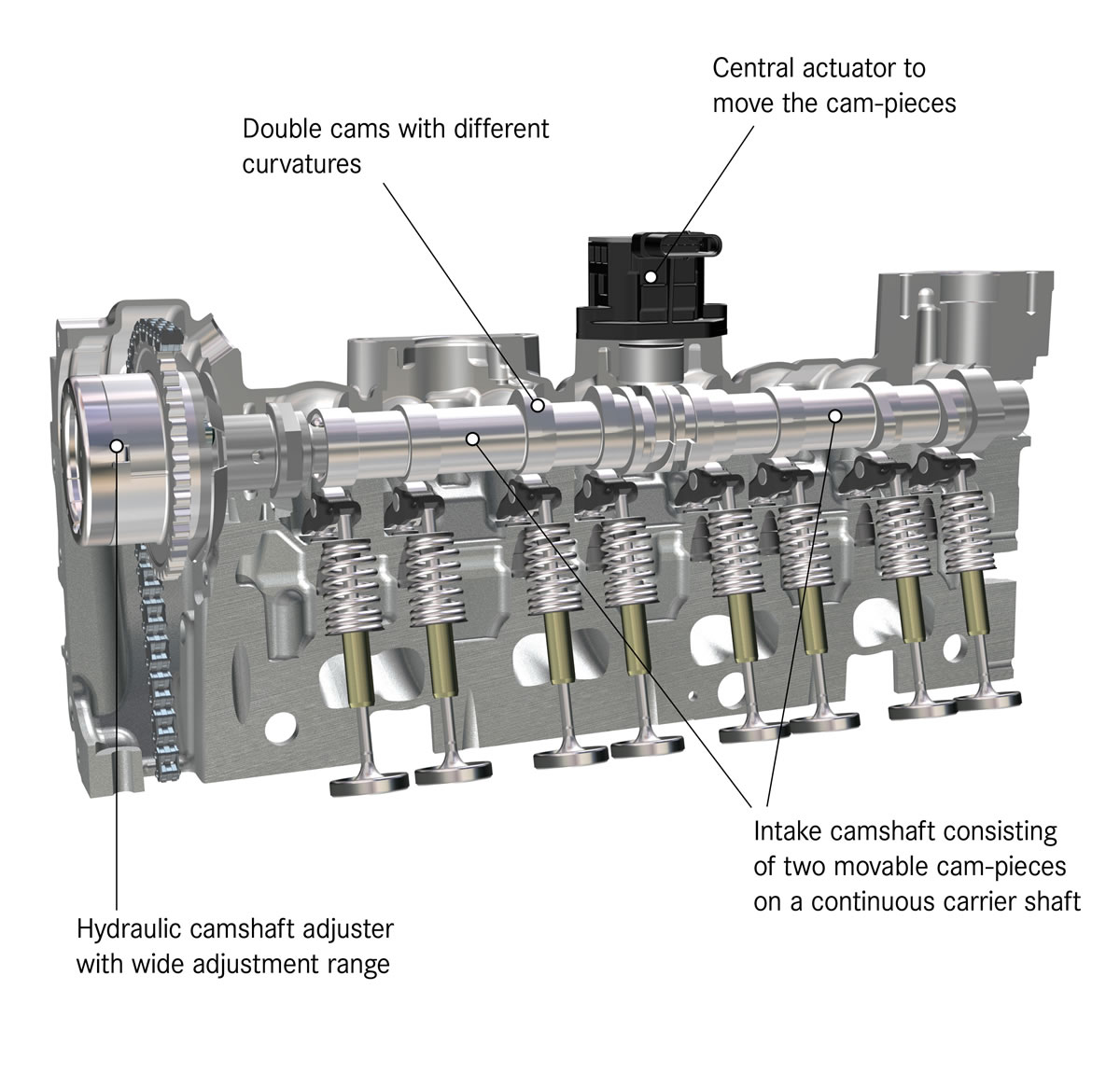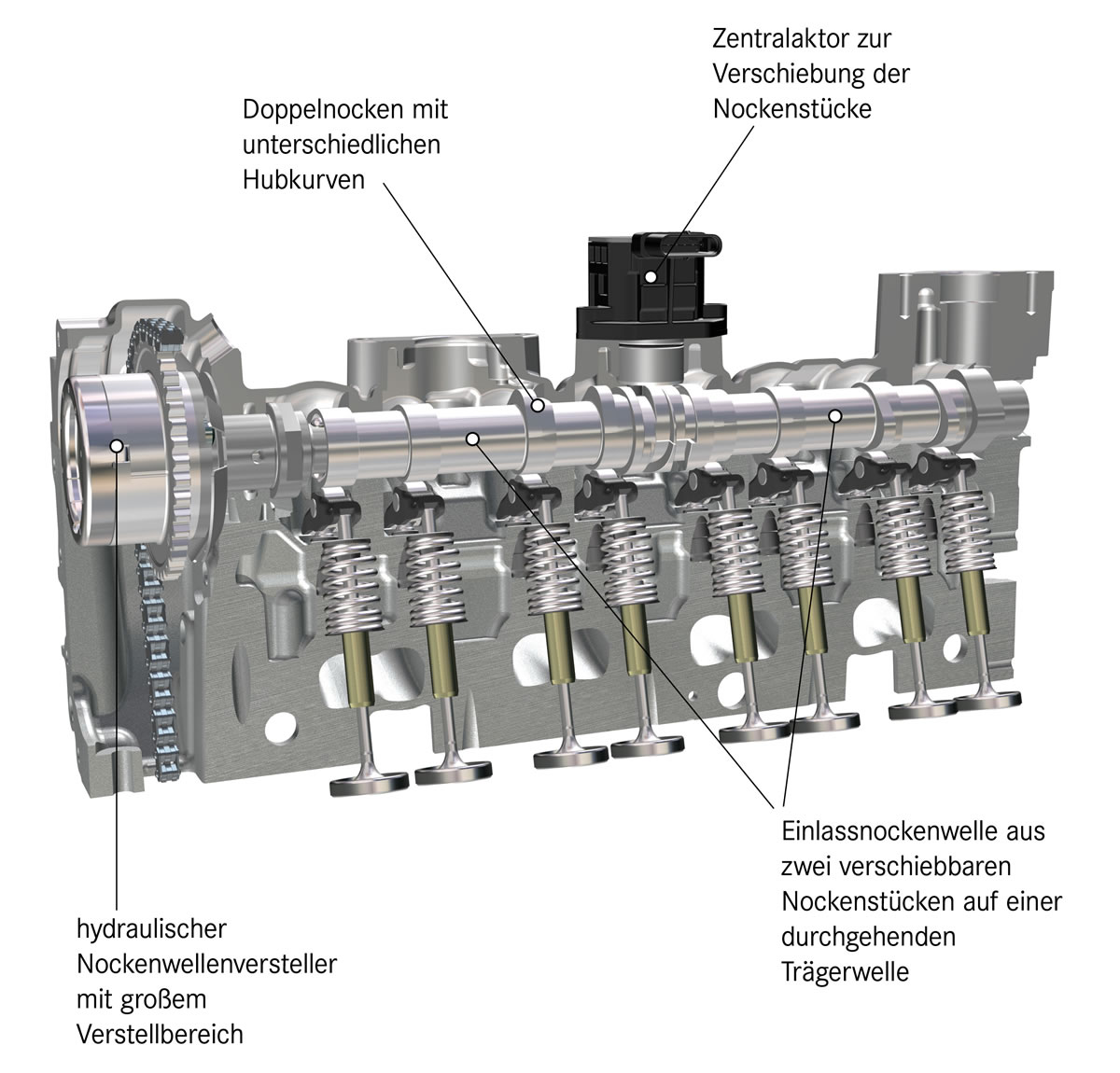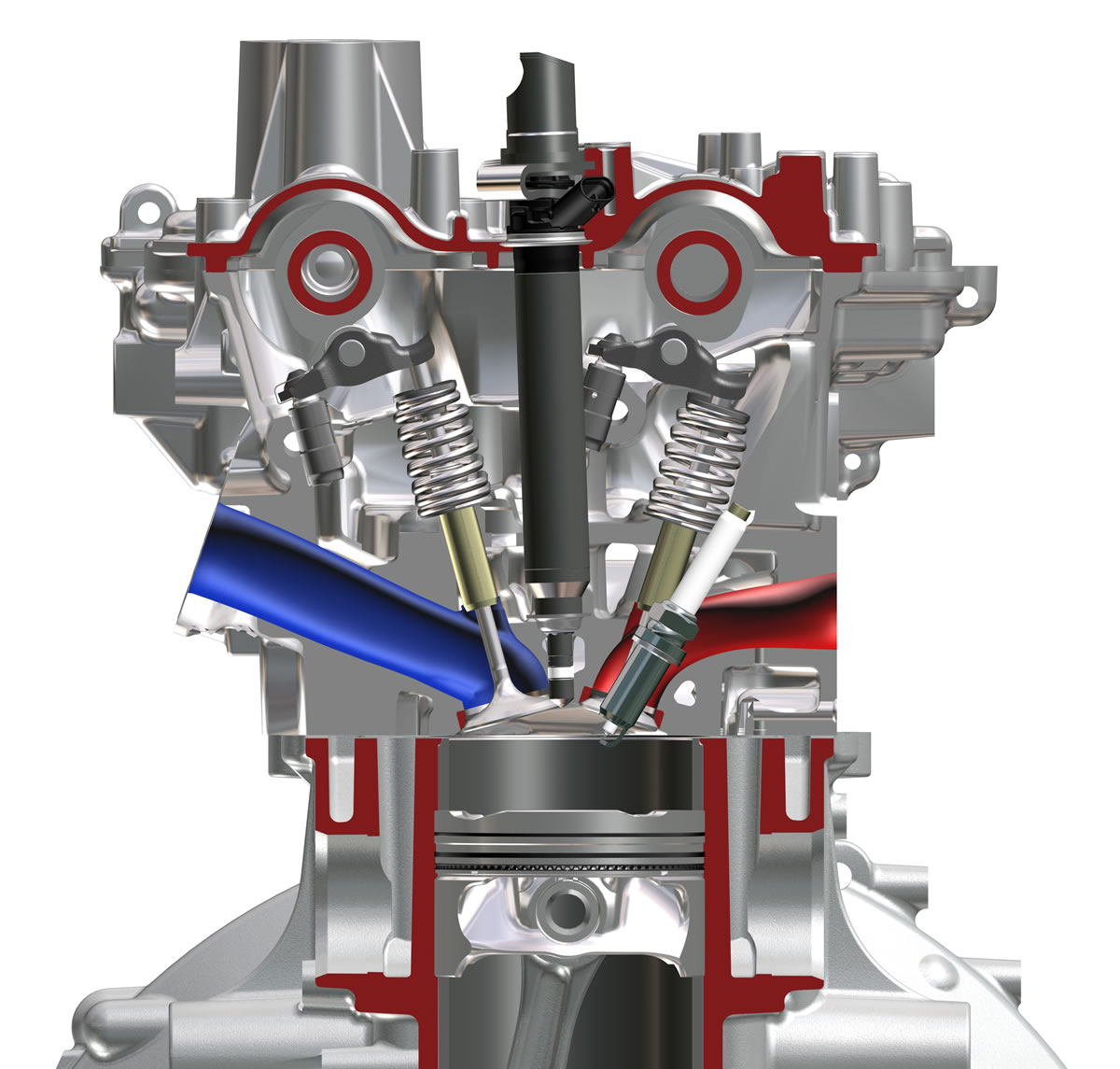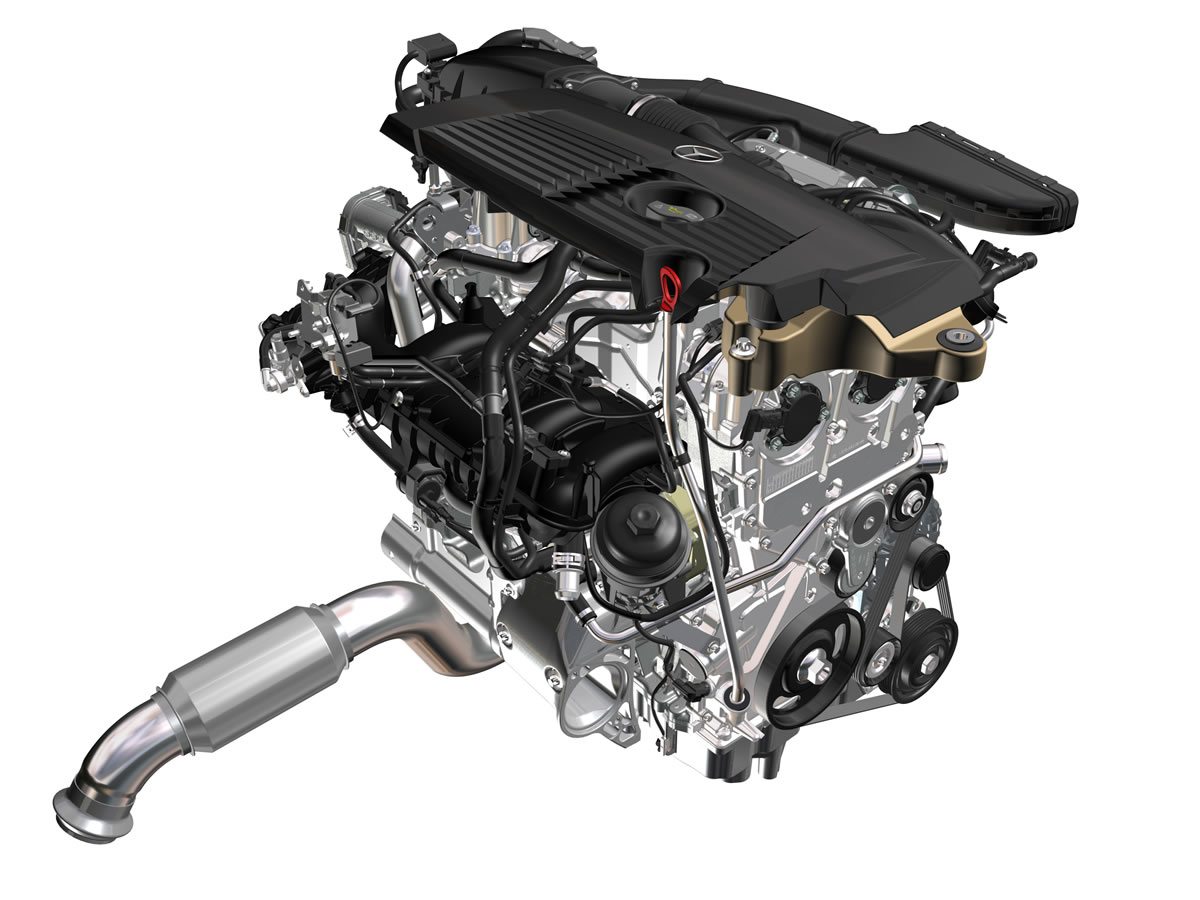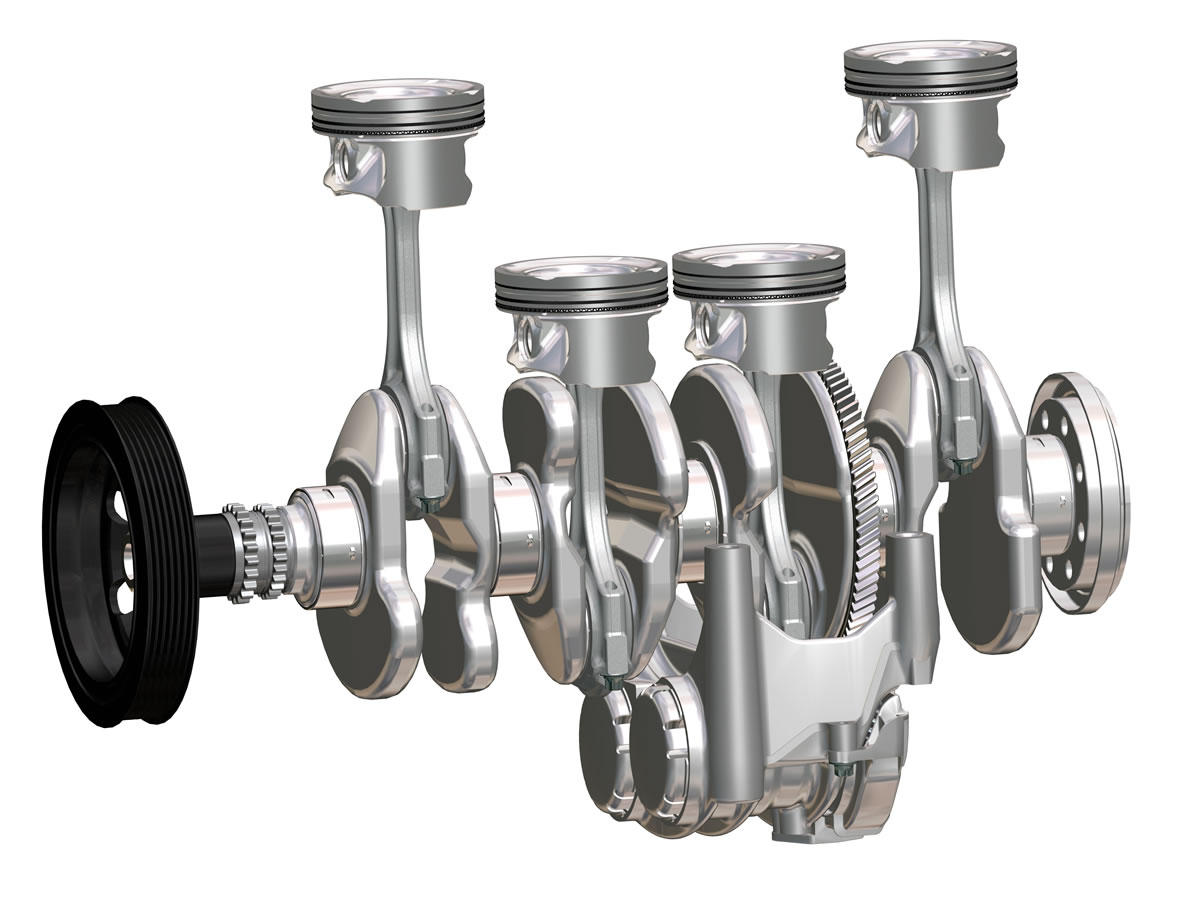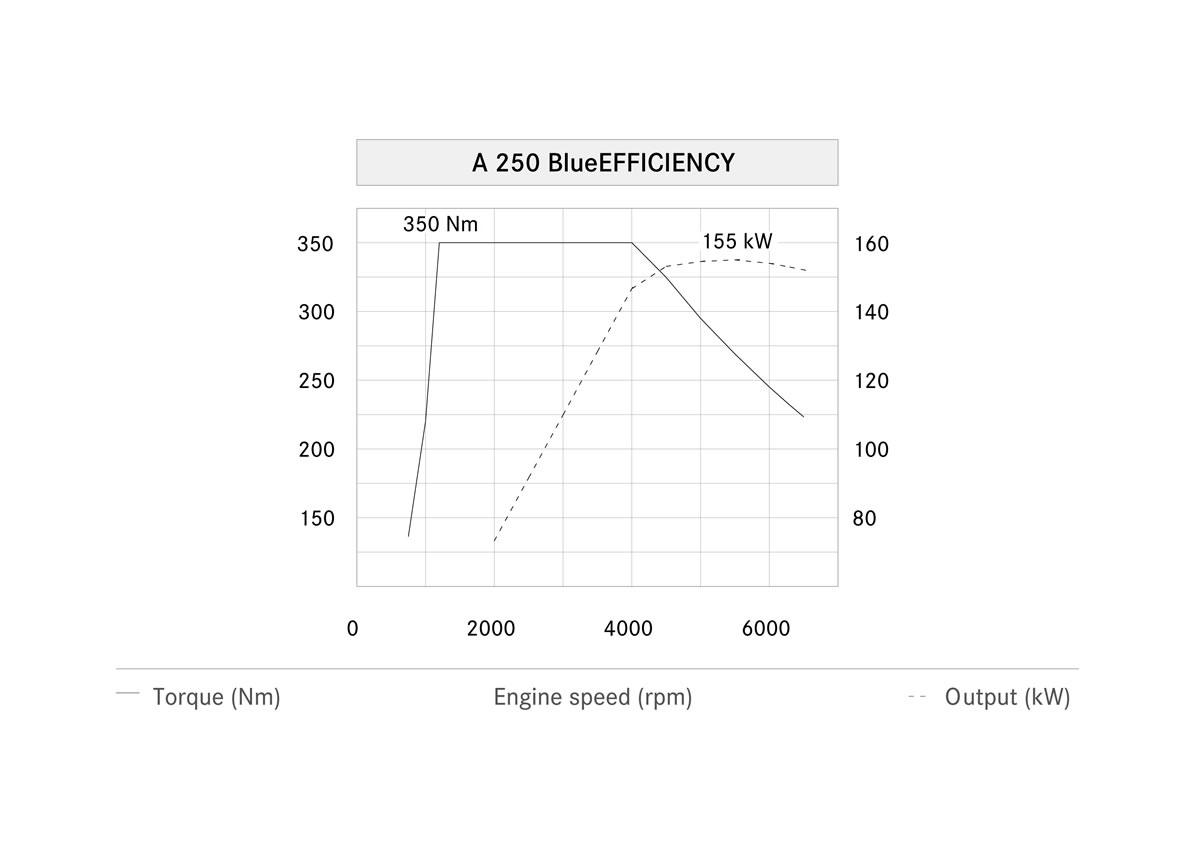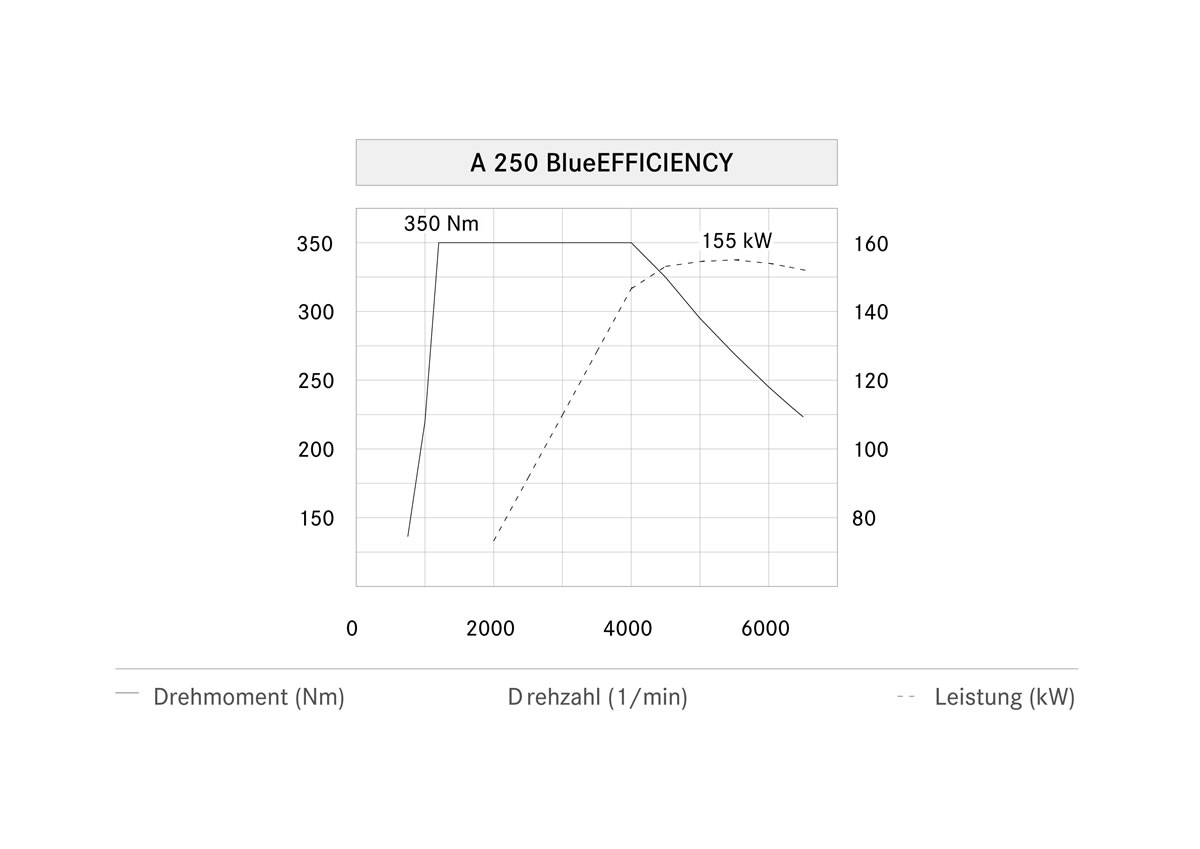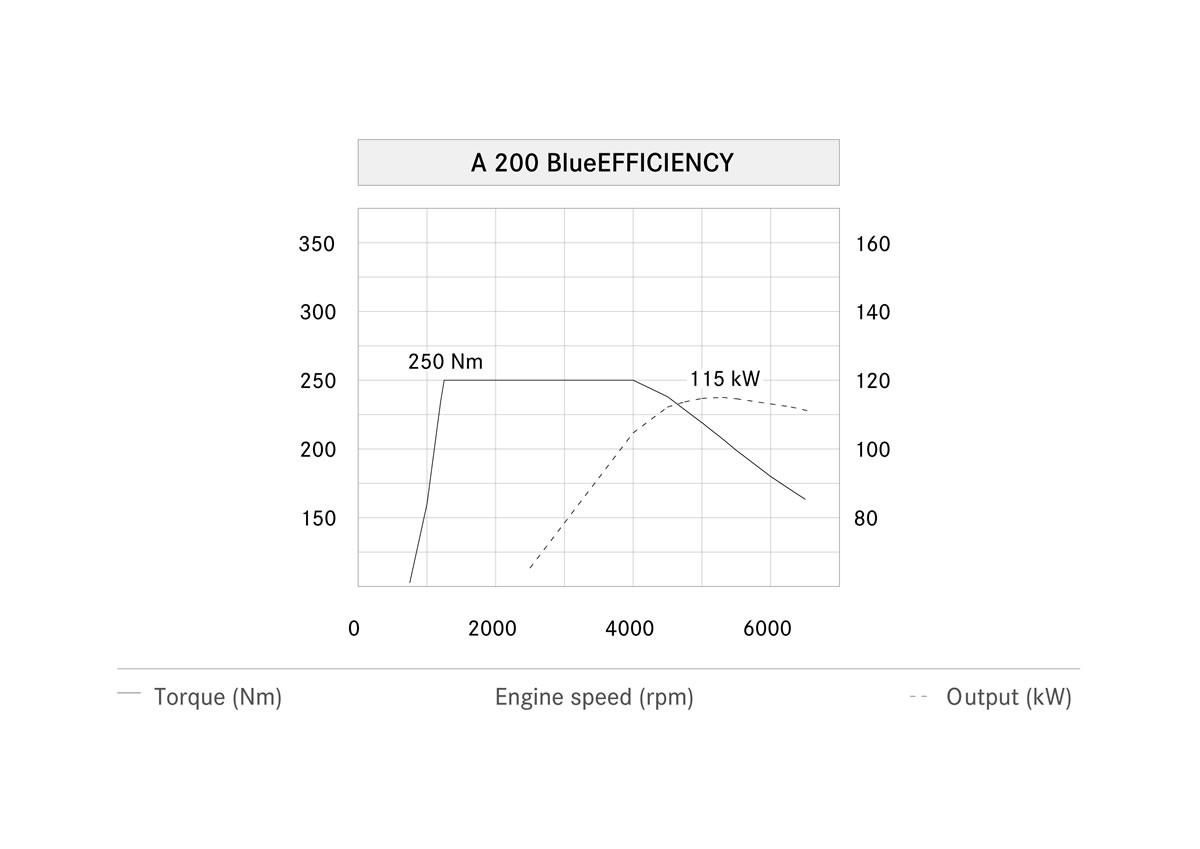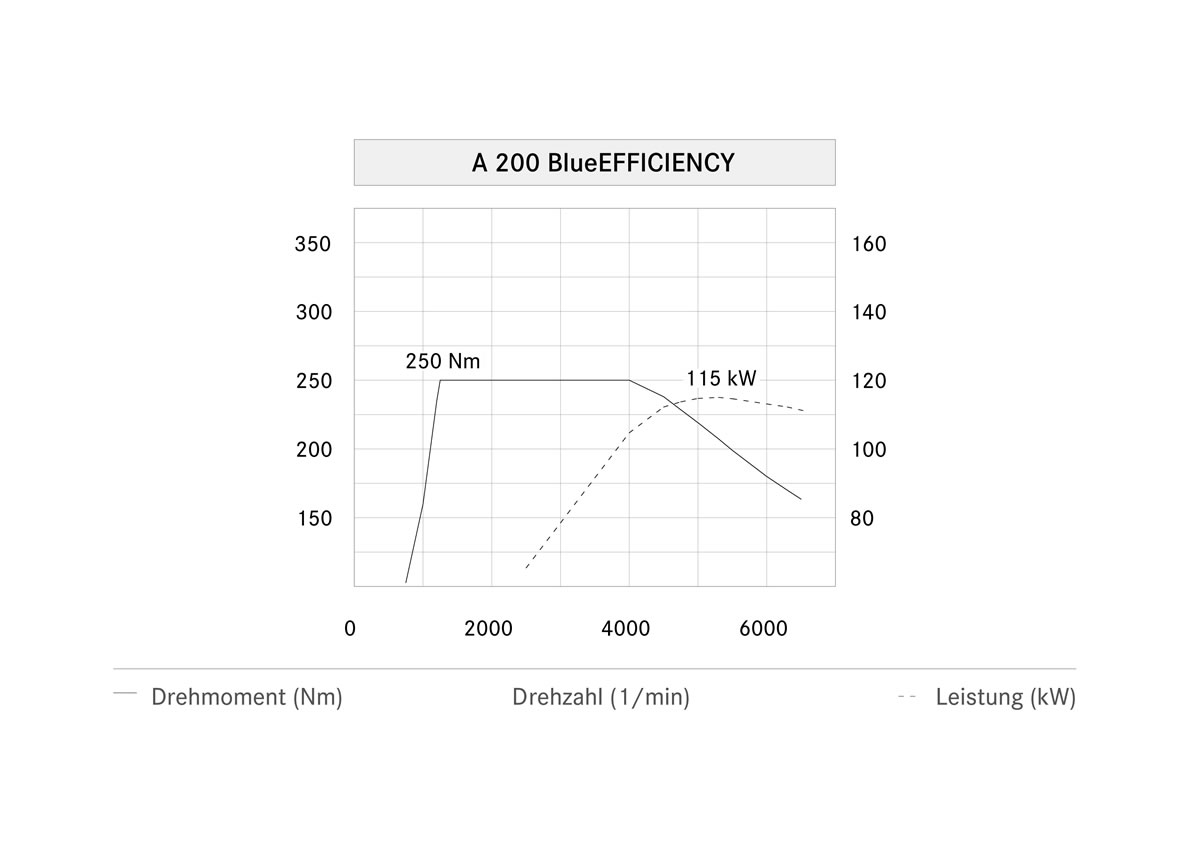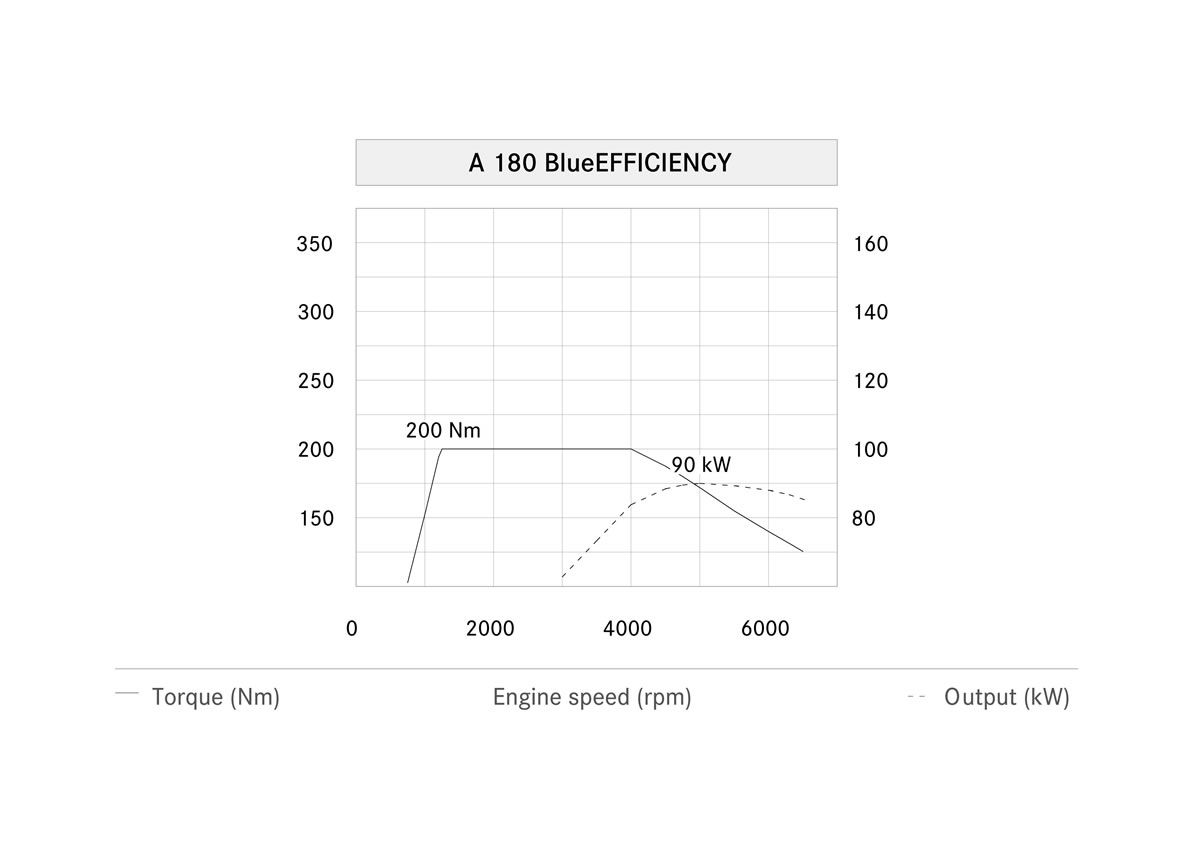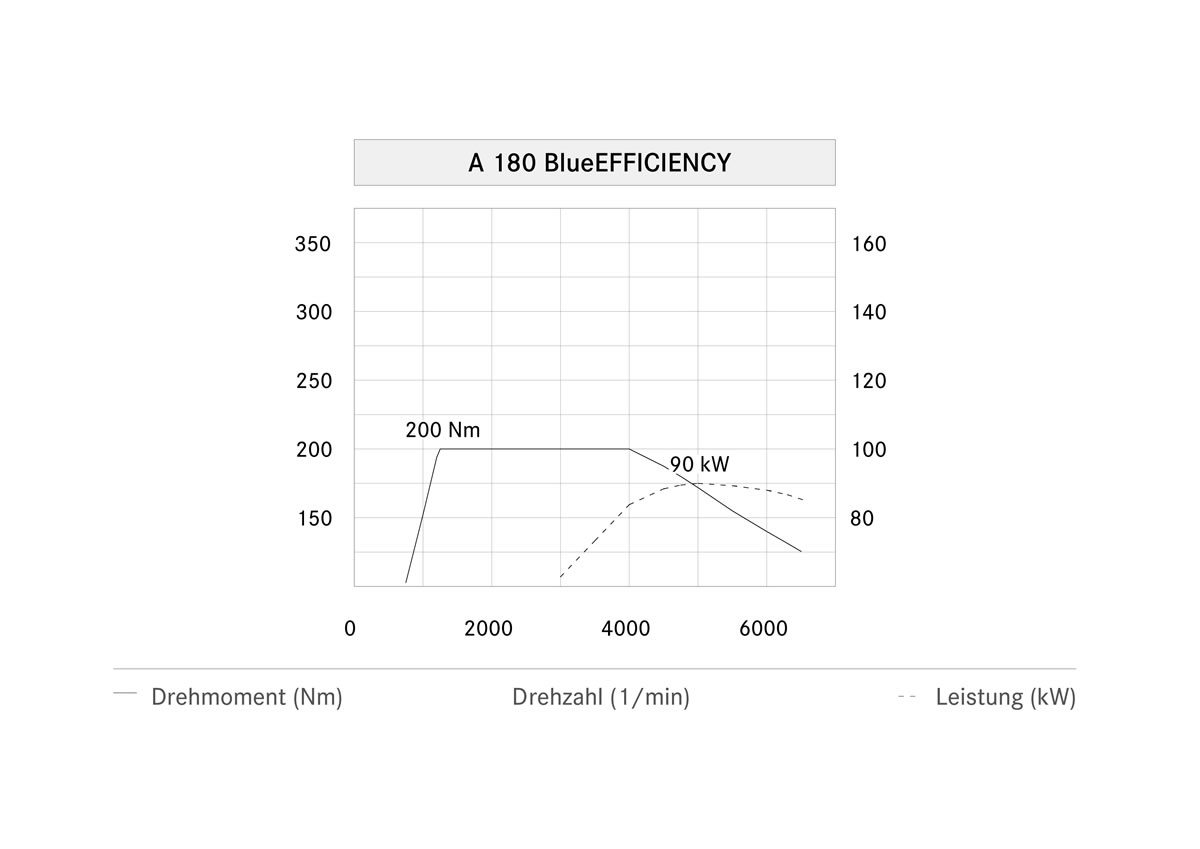Downsizing for the entry-level engines and downspeeding for the more powerful units – that is the Mercedes-Benz strategy for the diesel engines in the new A-Class. The wide range meets every performance requirement, and demonstrates the potential residing in the diesel engine: for the first time – with the A 180 CDI – a Mercedes-Benz will emit just 98 g of CO2 per kilometre. As a further highlight, the A 220 CDI already meets the Euro-6 emission standard only coming into effect from 2015.
The diesel engines also boast extreme efficiency and environmental friendliness, thanks to state-of-the-art injection technology and turbocharging. The A 180 CDI kicks off at 80 kW (109 hp) and offers maximum torque of up to 250 Nm (dual clutch transmission) or 260 Nm (6-speed manual transmission). In the A 200 CDI the maximum power output stands at 100 kW (136 hp), accompanied by maximum torque of 300 Nm. The A 220 CDI has a displacement of 2.2 litres and generates 125 kW (170 hp) with 350 Nm of torque, giving the performance of the A-Class a decidedly sporty touch.
From the S-Class to the A-Class: the diesel engines of the OM 651 series
Since its world premiere in 2008 the direct-injection diesel engine known as the OM 651 has been setting standards in terms of performance and torque characteristics, economy, emissions and smooth running. It is in more widespread use than any other Mercedes-Benz diesel engine and serves as a model of efficiency and power right up to the S-Class. For transverse installation the belt drive for the ancillary units, the installed position of the turbocharger and the air ducting have been modified.
No less than three versions are used in the new A-Class:
- Dynamic to drive, extremely efficient and outstandingly clean, the A 220 CDI is only available in combination with the 7G-DCT dual clutch transmission. The 125 kW (170 hp) top diesel is equipped with a weight-optimised crankshaft with individual bearing covers bolted from below and four counterweights, enabling it to tip the scales at around six kilograms less than a longitudinally installed OM 651 of the same displacement. The single-stage turbocharger has larger dimensions than that in the 80 and 100 kW variants. The A 200 CDI has multiple exhaust gas recirculation (see “Under the microscope”) to reduce nitrogen oxide emissions. It already meets the Euro-6 emission standard coming into force from 2015. With 112 g of CO2 per kilometre (provisional figure) the A 220 CDI sets new standards in its segment. With a displacement of 2.2 litres the engine is comparatively large, and therefore already agile at low rpm. “Downspeeding” is the term used by the engine specialists at Mercedes-Benz to describe this combination of a large displacement and low engine speeds. As a result it has been possible to make the ECONOMY mode of the 7G-DCT transmission decidedly economical and comfortable. If the driver selects “S”, gearshifts are performed much faster and the ratio spread uses the rpm reserves of the engine for dynamic performance.The performance of the A 220 CDI – which is available in BlueEFFICIENCY and Sport versions – is at sports car level with 7.8 seconds from zero to 100 km/h and a top speed of 227 km/h.
- The 1.8-litre engine variant is used in the A 180 CDI with the 7G-DCT dual clutch transmission and the A 200 CDI. The displacement was reduced by shortening the stroke (83 mm instead of 99 mm). The significantly longer connecting rods ensure lower transverse friction, and the two Lanchester balancer shafts are also of low-friction design. The single-stage turbocharger was optimised for efficiency and features adjustable vanes. With a distance between cylinders of 94 millimetres and cylindrical gears driving the camshafts, transverse installation and the necessary length restriction were part of the design specification from the very start.
To realise the start/stop function, the belt drive is decoupled from the crankshaft in all three engines.
Other common features include:
- Common rail technology with a rail pressure increased to 1800 bar. The maximum ignition pressure of 180 bar also contributes to the high power output and a muscular torque curve.
- The oil injection nozzles and the water pump are activated only when required, in order to save energy and fuel. The controlled oil pump additionally reduces oil flow and thus fuel consumption.
- The engine block is made of cast iron, the cylinder head of aluminium.
- A two-piece water jacket in the cylinder head provides for optimum cooling in the area of the combustion chamber plate. This enables an ignition pressure of 200 bar and a high specific power output.
- The cast iron barrels have undergone considerably finer honing than on the predecessor, also contributing to the reduction in fuel consumption.
- To compensate for the second-order forces which are inherent to four-cylinder in-line engines there are two Lanchester balancer shafts at the bottom of the engine block running in low-friction roller bearings rather than conventional plain bearings.
- The two-mass flywheel has been specifically designed for high engine torque at low engine speeds in order to isolate the crankshaft’s vibration stimuli, thereby contributing to the engine’s excellent smooth running.
Replete with Mercedes-Benz know-how: the OM 607
For the A 180 CDI with manual transmission Mercedes-Benz has had recourse to its cooperation with Renault to achieve fuel economy advantages from a compact, lightweight, low-friction engine which has been rigorously downsized. The common-rail four-cylinder with a rail pressure of 1600 bar is currently in its sixth generation, with more than 1.3 million units produced each year. This 1.5-litre engine with low-pressure EGR generates 80 kW (109 hp). With 98 g of CO2 per kilometre, it is among the most environmentally friendly diesels in the compact car segment. The turbocharger features variable turbine geometry (VTG).
This engine with the in-house designation OM 607 weighs around 30 kilograms less than an OM 651. Numerous components are specific to Mercedes-Benz, for example the OM 607 has the engine mountings of the M 270 petrol engine, as well as a special two-mass flywheel. The starter flanged onto the transmission, the alternator and the refrigerant compressor also come from the Mercedes modular system, and are driven by a belt with six grooves.
Like all Mercedes engines, the OM 607 was required to absolve the extensive engine test programme involving bench-testing and endurance runs. The application effort devoted to the OM 607 by Mercedes-Benz was very considerable. In a joint project team of Mercedes and Renault personnel the engine was especially improved with respect to NVH and driveability. Coordination work also went into the ECO start/stop function included as standard. This Mercedes-specific feature also operates at temperatures down to minus 10 degrees Celsius, for example, and can therefore make a more frequent contribution to fuel economy.
Overview of technical data for the A-Class with diesel engine
| Model | A 180 CDI* | A 180 CDI ** | A 200 CDI*** | A 220 CDI** | |
| Cylinder arrangement/number | 4/in-line | 4/in-line | 4/in-line | 4/in-line | |
| Displacement | [cc] | 1461 | 1796 | 1796 | 2143 |
| Rated output | [kW/hp] at [rpm] | 80/109 4000 | 80/109 3200-4600 | 100/136 3600-4400 | 125/170 3600-4000 |
| Rated torque | [Nm] at [rpm] | 260 1750-2500 |
250 1400-2800 |
300 1600-3000 |
350 1600-3200 |
| Fuel consumption, combined | [l/100 km] | 3.8 | 4.1 | 4.3 (4.1) | n/a |
| CO2 emissions, combined | [g/km] | 98 | 109 | 111 (109) | n/a |
* manual transmission,
** 7G-DCT dual clutch transmission,
*** figures for 7G-DCT dual clutch transmission in brackets


